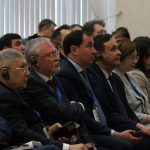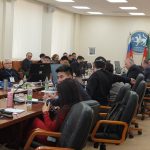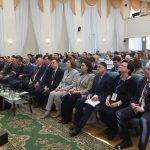International scientific conference “Russia and China: current issues in studying the history and archaeology of Steppe Eurasia”
On April 14–16, 2025, the Tatarstan Academy of Sciences hosted the International scientific conference “Russia and China: current issues in studying the history and archaeology of Steppe Eurasia” aimed at discussing key aspects of the historical past of the two nations with the participation of leading Russian and Chinese scholars.
The conference was organized by the Tatarstan Academy of Sciences with the support of the Russian Ministry of Science and Higher Education, the Russian Historical Society, and the Cabinet of Ministers of Tatarstan.
The opening ceremony featured speeches by K.I. Mogilevsky, Deputy Minister of Science and Higher Education of the Russian Federation; M.B. Piotrovsky, Director of the State Hermitage Museum; R.N. Minnikhanov, President of the Tatarstan Academy of Sciences; Cao Longquan Цао Лунцюань, Acting Consul General of the People’s Republic of China in Kazan; I.F. Popova, Director of the Institute of Oriental Manuscripts RAS; A.K. Alikberov, Director of the Institute of Oriental Studies RAS and others.
Distinguished speakers at the plenary session included heads of RAS institutes: N.N. Kradin (Vladivostok) and A.V. Polyakov (St. Petersburg); A.G. Sitdikov, Director of the Institute of Archaeology named after A.Kh. Khalikov (Tatarstan Academy of Sciences); leading Chinese scholars Wei Jian Вэй Цзянь, Wang Jianxin Ван Цзяньсинь, and Bai Yudong Бай Юйдун; researchers from Barnaul.
The conference brought together over 200 participants, including more than 50 leading specialists representing academic and educational institutions from Russia (Moscow, St. Petersburg, Kazan, Astrakhan, Barnaul, Budyonnovsk, Vladivostok, Yoshkar-Ola, Kemerovo, Novosibirsk, Chelyabinsk, Elista, Ulan-Ude) and China (Beijing, Lanzhou, Xi’an, Tianjin, Shijiazhuang, Hohhot, Chongqing), as well as over 70 online attendees and around 80 invited guests from academic, educational, and cultural institutions of Tatarstan.
During the panel sessions, scholars discussed historical processes in Steppe Eurasia, new interdisciplinary research methodologies, the application of advanced technologies in archaeology (including non-destructive methods), findings from archaeological excavations, cultural exchanges based on historical and archaeological studies, including research on Chinese artifacts such as bronze mirrors, ceramics, and porcelain. Special attention will be paid to the practices of preserving the cultural heritage of the Tea Road and the Silk Road.
The event also featured two roundtable discussions: ” Aspects of interaction between Russian and Chinese historians” and “Transcontinental trade routes from Antiquity to the Modern era”. Additionally, exhibitions were held showcasing publications from the Russian Historical Society, the Institute of Archaeology named after A.Kh. Khalikov TAS, the Institute of History named after Sh. Marjani TAS. An archaeological findings exhibition displayed the latest excavation results conducted by the Institute of Archaeology TAS under Tatarstan State program “Preserving the national identity of the Tatar people.”
The conference concluded with participants exploring the historical and cultural heritage of Tatarstan. Following the discussion of the presentations, the participants concluded that the conference marked a significant milestone in the collaboration between Russian and Chinese scholars, demonstrating a shared commitment to systematically organizing international initiatives for the study and promotion of the historical and cultural heritage of Steppe Eurasia. The scholars emphasized the importance of the Eurasian Steppe as a unique region where, over millennia, cultures interacted, technologies were exchanged, and transcontinental trade routes (such as the Silk Road, the Volga-Caspian trade route, and the Tea Road) flourished. They also highlighted the contribution of interdisciplinary research — combining archaeology, history, and ethnography with digital technologies — to the study of migrations, cultural synthesis, and statehood among Eurasian peoples. Special attention was given to the importance of countering historical falsification, particularly in the context of the 80th anniversary of the Victory over fascism and militarism..
In conclusion, the conference resulted in important agreements that open new prospects for cooperation. The parties identified the following priority areas for joint work:
• study of Paleometallic Age and early nomads archaeology;
• study of archaeology and history of medieval states in Steppe Eurasia;
• study of transcontinental trade links;
• preservation and study of the historical and cultural heritage of Steppe Eurasia;
• exchange of specialists in humanities research;
• translation of proceedings by Tatarstan historians and archaeologists into Chinese;
• research in the archives of Chinese scientific institutions.
The next conference will be held in China.




